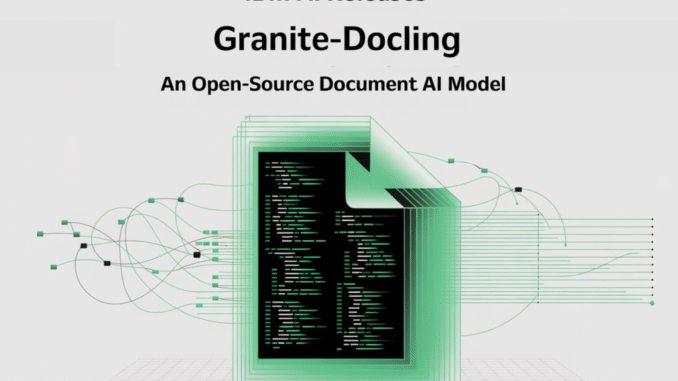
IBM has released Granite-Docling-258M, an open-source (Apache-2.0) vision-language model designed specifically for end-to-end document conversion. The model targets layout-faithful extraction—tables, code, equations, lists, captions, and reading order—emitting a structured, machine-readable representation rather than lossy Markdown. It is available on Hugging Face with a live demo and MLX build for Apple Silicon.
What’s new compared to SmolDocling?
Granite-Docling is the product-ready successor to SmolDocling-256M. IBM replaced the earlier backbone with a Granite 165M language model and upgraded the vision encoder to SigLIP2 (base, patch16-512) while retaining the Idefics3-style connector (pixel-shuffle projector). The resulting model has 258M parameters and shows consistent accuracy gains across layout analysis, full-page OCR, code, equations, and tables (see metrics below). IBM also addressed instability failure modes observed in the preview model (e.g., repetitive token loops).
Architecture and training pipeline
Backbone: Idefics3-derived stack with SigLIP2 vision encoder → pixel-shuffle connector → Granite 165M LLM.
Training framework: nanoVLM (lightweight, pure-PyTorch VLM training toolkit).
Representation: Outputs DocTags, an IBM-authored markup designed for unambiguous document structure (elements + coordinates + relationships), which downstream tools convert to Markdown/HTML/JSON.
Compute: Trained on IBM’s Blue Vela H100 cluster.
Quantified improvements (Granite-Docling-258M vs. SmolDocling-256M preview)
Evaluated with docling-eval, LMMS-Eval, and task-specific datasets:
Layout: MAP 0.27 vs. 0.23; F1 0.86 vs. 0.85.
Full-page OCR: F1 0.84 vs. 0.80; lower edit distance.
Code recognition: F1 0.988 vs. 0.915; edit distance 0.013 vs. 0.114.
Equation recognition: F1 0.968 vs. 0.947.
Table recognition (FinTabNet @150dpi): TEDS-structure 0.97 vs. 0.82; TEDS with content 0.96 vs. 0.76.
Other benchmarks: MMStar 0.30 vs. 0.17; OCRBench 500 vs. 338.
Stability: “Avoids infinite loops more effectively” (production-oriented fix).
Multilingual support
Granite-Docling adds experimental support for Japanese, Arabic, and Chinese. IBM marks this as early-stage; English remains the primary target.
How the DocTags pathway changes Document AI
Conventional OCR-to-Markdown pipelines lose structural information and complicate downstream retrieval-augmented generation (RAG). Granite-Docling emits DocTags—a compact, LLM-friendly structural grammar—which Docling converts into Markdown/HTML/JSON. This preserves table topology, inline/floating math, code blocks, captions, and reading order with explicit coordinates, improving index quality and grounding for RAG and analytics.
Inference and integration
Docling Integration (recommended): The docling CLI/SDK automatically pulls Granite-Docling and converts PDFs/office docs/images to multiple formats. IBM positions the model as a component inside Docling pipelines rather than a general VLM.
Runtimes: Works with Transformers, vLLM, ONNX, and MLX; a dedicated MLX build is optimized for Apple Silicon. A Hugging Face Space provides an interactive demo (ZeroGPU).
License: Apache-2.0.
Why Granite-Docling?
For enterprise document AI, small VLMs that preserve structure reduce inference cost and pipeline complexity. Granite-Docling replaces multiple single-purpose models (layout, OCR, table, code, equations) with a single component that emits a richer intermediate representation, improving downstream retrieval and conversion fidelity. The measured gains—in TEDS for tables, F1 for code/equations, and reduced instability—make it a practical upgrade from SmolDocling for production workflows.
Demo
Summary
Granite-Docling-258M marks a significant advancement in compact, structure-preserving document AI. By combining IBM’s Granite backbone, SigLIP2 vision encoder, and the nanoVLM training framework, it delivers enterprise-ready performance across tables, equations, code, and multilingual text—all while remaining lightweight and open-source under Apache 2.0. With measurable gains over its SmolDocling predecessor and seamless integration into Docling pipelines, Granite-Docling provides a practical foundation for document conversion and RAG workflows where precision and reliability are critical.
Check out the Models on Hugging Face and Demo here. Feel free to check out our GitHub Page for Tutorials, Codes and Notebooks. Also, feel free to follow us on Twitter and don’t forget to join our 100k+ ML SubReddit and Subscribe to our Newsletter.
Asif Razzaq is the CEO of Marktechpost Media Inc.. As a visionary entrepreneur and engineer, Asif is committed to harnessing the potential of Artificial Intelligence for social good. His most recent endeavor is the launch of an Artificial Intelligence Media Platform, Marktechpost, which stands out for its in-depth coverage of machine learning and deep learning news that is both technically sound and easily understandable by a wide audience. The platform boasts of over 2 million monthly views, illustrating its popularity among audiences.




Be the first to comment